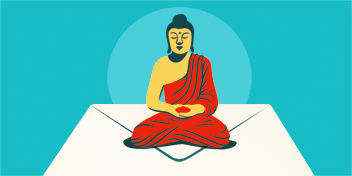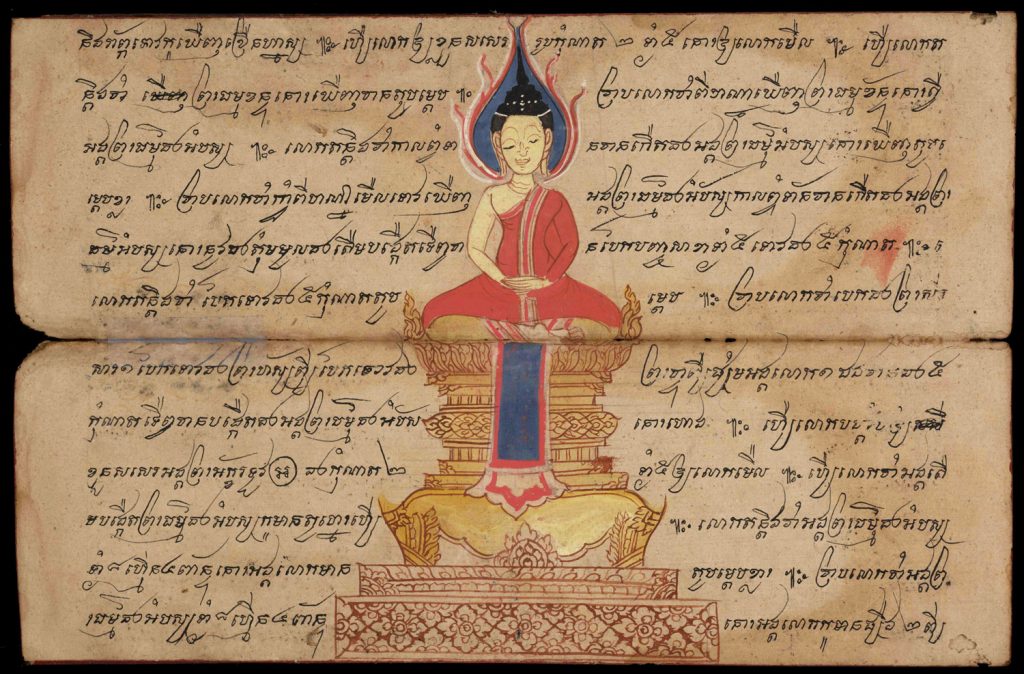The Sources of Buddhist Traditions is a monthly column from three of the major digital resources for Buddhist research, texts, and translation: Buddhist Digital Resource Center, The Treasury of Lives, and 84000: Translating the Words of the Buddha. Focusing on stories, texts, translation, and teachers, the series will illuminate aspects of Buddhist practice, thought, and tradition.
In the Kampong Cham province of Cambodia, not far from a section of the Mekong River, a temple known as Wat Phum Thmei Serey Mongkol houses the most complete library of palm leaf texts in the country. Having outlasted colonialism and civil war when so many libraries did not, the library is a rare exception and a testament to the power of preservation. Scholars estimate that between 1975 and 1990 more than 95 percent of manuscripts in Cambodia disappeared, either through neglect or outright destruction at the hands of the Khmer Rouge. This is what makes the Wat Phum Thmei library so remarkable. No other library emerged from the Khmer Rouge era as unscathed.
Traditionally in Cambodia and Southeast Asia more broadly, Buddhist texts were etched onto palm leaves or inked onto even more delicate bark paper, which made them vulnerable to the ravages of insects, humidity, and fire. To protect the texts from loss, scribes would regularly recopy manuscripts, transmitting knowledge from generation to generation. Although manuscript production had largely ceased in Cambodia by the time the Khmer Rouge came to power in 1975, manuscripts remained crucial sources for Buddhist rituals, sermons, meditation instructions, traditional astrology, and medicine. Buddhist monasteries, which were the center of intellectual life in many villages, continued to hold extensive palm leaf libraries.
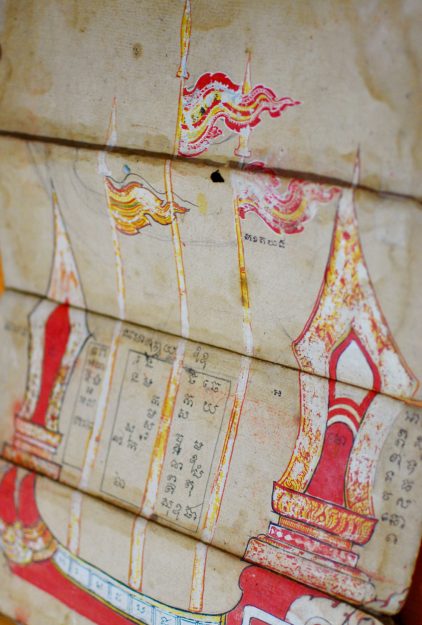
But in its quest to remake Cambodian society, the Khmer Rouge violently targeted Buddhist institutions and destroyed temple libraries on a mass scale. In May 1975, Pol Pot, the Khmer Rouge’s leader, and Nuon Chea, the regime’s “chief ideologist,” announced a program that included a plan to “defrock all Buddhist monks and put them to work growing rice,” Ian Harris writes in Buddhism in a Dark Age: Cambodian Monks Under Pol Pot. Thousands of monks were killed, disrobed, or forced into exile. Texts were burned, buried, or woven into hats for the military. Harris writes that in 1978, Yun Yat, the minister of culture, information, and propaganda, declared, “Buddhism is dead and the ground has been cleared for the foundations of a new revolutionary culture.”Although Buddhist practices and institutions eventually recovered after the 1979 fall of the Khmer Rouge, thousands of Buddhist manuscripts were lost forever. Today, collections that rival Wat Phum Thmei’s are either an amalgamation of multiple libraries or missing many texts.
“[Wat Phum Thmei] offers Cambodians and others the best chance of reconstructing what many monastic libraries must have been like at the end of the era of manuscript copying in Cambodia,” says Dr. Trent Walker, a scholar of Southeast Asian Buddhism, lecturer at Stanford University, and advisor to the Buddhist Digital Resource Center. Although most surviving manuscripts in Cambodia were created between 1850 and 1950, the texts themselves date back to the sixteenth century or earlier because manuscripts were regularly copied by scribes. Indeed, according to Dr. Kunthea Chhom, an epigraphist working with Cambodia’s Ministry of Culture, the content and form of the manuscripts echo inscriptions of the Angkorian period, the 9th–14th century era of the Khmer Empire that gave rise to the world famous Angkor Wat. “As a whole,” Chhom says, “the manuscripts reflect both the continuity of the Angkorian intellectual tradition and the [flourishing] of the language.”
Importantly, the Wat Phum Thmei collection does not simply contain old copies of the standard Pali canon. It includes a diversity of texts that reflect the richness of Cambodian Buddhist practice and offer a snapshot of pre-colonial Cambodia society, revealing a complex cultural and spiritual landscape. The majority of texts in Wat Phum Thmei’s library are “bitexts,” bilingual sermons and treatises that elegantly interweave Pali and Khmer. They include the Jataka tales, the Paṭham trās’ (the oldest life narrative of the Buddha found in Cambodia), and several copies of an unusual work known as the Cetanābhedā, or “the scattering of the [32] minds,” a story collection that exists only in manuscript form and reconciles Buddhist conceptions of the mind with the Southeast Asian idea that humans have multiple internal spirits that sometimes wander off and need to be recalled to the body—much like the Tibetan concept of bla, or “energy body.”
For decades, the Fonds pour l’Édition des Manuscrits du Cambodge (FEMC), an initiative run by local Cambodians and backed by the prestigious French research institute École française d’Extrême-Orient (EFEO), was the leading organization tackling the painstaking work of preserving Cambodia’s manuscripts, including those from Wat Phum Thmei. Between 1990 and 2012, the EFEO-FEMC team visited well over a thousand monasteries, with a focus on libraries in the provinces of Phnom Penh, Siem Reap, Kandal, and Kampong Cham. In addition to cleaning and reassembling texts in monastic libraries, the team extensively documented the contents of those libraries in a two-volume catalog, photographing the texts to guard against loss in case the physical manuscripts were later destroyed.
Leading the effort were local scholars Leng Kok-An and the late Kun Sopheap. Having spent more than thirty years reading and reassembling manuscripts, assisted in their early work by older monks and scholars who had studied manuscripts between the 1940s and 1960s, Kok-An and Sopheap were two of the only people in the world with the knowledge necessary to identify and reassemble surviving texts from a jumble of palm leaves. Surviving collections—many concealed from the Khmer Rouge in rafters and, in one case, a false ceiling in a monastery—were often found in advanced states of decay and disorganization, with many texts missing or damaged. Stuffed in bags, heaped in piles, or even chewed by insects and rats, the palm leaves had to be separated, cleaned, and sometimes re-inked with oil and a traditional ink mixture before being identified and reassembled into texts. Leng Kok-An estimates that of the monasteries visited by the EFEO-FEMC team between 1990 and 2012, only ten percent still possessed manuscripts. According to the EFEO, 358 of the 433 monasteries visited in Phnom Penh and Kandal provinces did not have even a single manuscript.
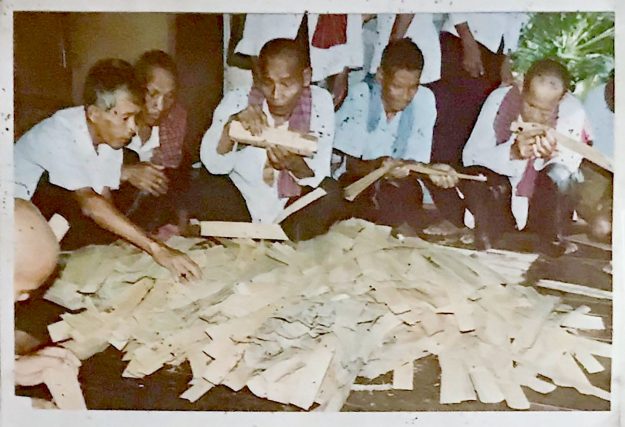
Wat Phum Thmei’s collection was saved thanks to the foresight of its head monk. In 1975, as the Khmer Rouge was assuming control of Cambodia, the head monk distributed manuscripts among devout villagers for safekeeping. At some point after the fall of the Khmer Rouge, the texts made their way back to the monastery. The EFEO-FEMC discovered them, disorganized and dirty from their years in hiding, in 1996. It took two years to restore the approximately 2,500 manuscripts in Wat Phum Thmei’s collection. During that time, Leng Kok-An met a villager who offered a hint of the treasures that might still exist in the Cambodian countryside. The villager possessed a copy of an extremely rare cosmological treatise known as the Trai Ṭā, which integrates Brahmanical themes and lore with a Khmer Buddhist understanding of the universe. The villager showed Kok-An the manuscript but did not let him photograph it (Wat Phum Thmei has an incomplete copy of the Trai Bhed, another very rare, closely related manuscript, available in the Buddhist Digital Resource Center’s online library).
The work of preserving manuscripts in Cambodia continues. In 2019, with a grant from A Khmer Buddhist Foundation, the Buddhist Digital Resource Center (BDRC) launched a project to digitize surviving manuscripts in Cambodia and help preserve these irreplaceable artifacts. As part of the project, Leng Kok-An once again conducted extensive fieldwork, particularly at Wat Phum Thmei and surrounding monasteries, and the library at Wat Phum Thmei has since expanded even more. The temple library now holds 5,000–6,000 manuscripts, enhanced with collections donated by nearby monasteries. Once the BDRC project is complete, the images of the texts will be made freely available online, with a website specifically designed for the Cambodian community slated for launch at the end of the year. The new digital resource will not only help preserve a priceless record of Cambodian society and history, but it will also provide modern readers access to a trove of Cambodian Buddhist literature, and bring the texts to the world by making new translations possible. A forthcoming book by Walker, Until Nirvana’s Time: Buddhist Songs from Cambodia (Shambhala Publications, Fall 2022), will introduce some of these texts to the English-speaking world.
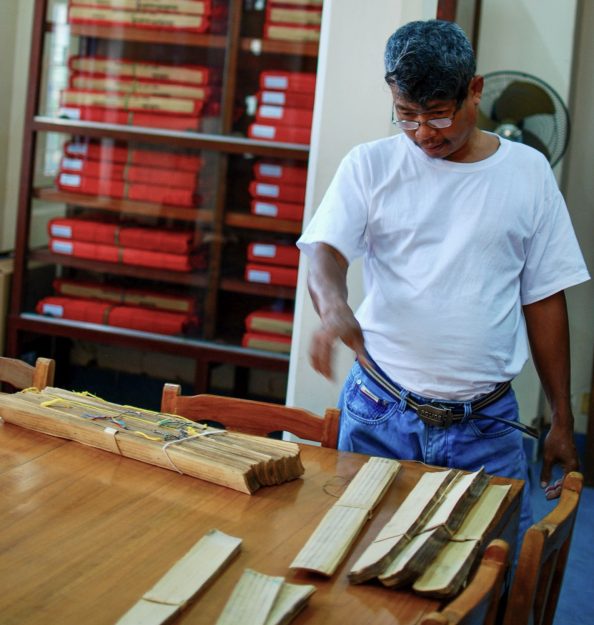
From Vulture Peak to palm leaves and printing press to PDF, to follow the history of dharma transmission is to follow the evolution of knowledge technology, a series of advances born from humanity’s resolute desire to learn and teach. Memories fade, paper burns, hard drives fail, but knowledge remains, and each iteration leaves its mark on the world, in bits, bytes, and palm leaves. “All conditioned things are of a nature to decay,” the Buddha said just before his death (Dīgha Nikāya, translated by Maurice Walshe). “Strive on untiringly.”
Thank you for subscribing to Tricycle! As a nonprofit, we depend on readers like you to keep Buddhist teachings and practices widely available.
